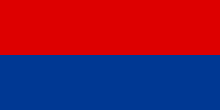Kingdom of Serbia (medieval)
| Kingdom of Serbia | ||||||||||
| Краљевина Србија Kraljevina Srbija | ||||||||||
| ||||||||||
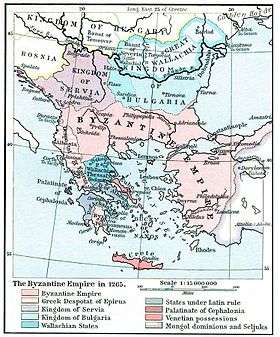 Serbia, 1265, during the rule of Stefan Uroš I of Serbia | ||||||||||
| Capital | Ras, Skopje | |||||||||
| Languages | Serbian (Old Serbian) | |||||||||
| Religion | † Eastern Orthodoxy (Serbian Orthodox Church) | |||||||||
| Government | Monarchy | |||||||||
| King | ||||||||||
| • | 1196–1228 | Stefan Nemanjić (Grand Prince↑King) | ||||||||
| • | 1322–1331 | Stefan Dečanski | ||||||||
| • | 1331–1346 | Stefan Dušan (King↑Emperor) | ||||||||
| Historical era | Medieval | |||||||||
| • | Crowning of Stefan Nemanjić The First-crowned | 1217 | ||||||||
| • | Autocephaly of the Serbian Church (Sava, Archbishop of Serbs) | 1219 | ||||||||
| • | Crowning of Stefan Dušan (Emperor of Serbs and Greeks) | 16 April 1346 | ||||||||
| ||||||||||
| Today part of | | |||||||||
The Kingdom of Serbia (Serbian: Краљевина Србија/Kraljevina Srbija), or Serbian Kingdom (Српско краљевство/Srpsko kraljevstvo), was a medieval Serbian state that existed from 1217 to 1346, ruled by the Nemanjić dynasty. The Grand Principality of Serbia was elevated with the coronation of Stefan Nemanjić as king by his brother, bishop Sava, after inheriting all territories unified by their father, Stefan Nemanja. The kingdom was proclaimed an empire on 16 April 1346.
Background
Grand Principality of Serbia
In 1083, Constantine Bodin, the King of Duklja and Ruler of the Serbs, had appointed his nephews Vukan and Marko as vassals in Rascia (historiographical name), one of the four provinces of his realm, situated in the hinterland along with Zachumlje, Bosnia, and the seat in Duklja.[1] Each province had its own nobility and institutions, and each acquired a member of the Vojislavljevići to head as Župan.[1] The Byzantine Empire launched a campaign on Duklja between 1089 and 1091 and possibly captured Bodin. A civil war broke out in the realm among Bodin's relatives, greatly weakening Duklja. Vukan took the opportunity to assert himself and broke away, claiming the title of Grand Prince of Serbia.[2]
Rascia, Bosnia, and Zahumlje all became independent in 1091. Up to this point, Duklja had been the center of the Serbian realm, as well as the main resistance to Byzantium in the Balkans.[3] After 1091 Rascia became the most powerful of the Serbian states, under the rule of the Vukanović dynasty, and it remained so throughout the rest of the Middle Ages.[4] Rascia also replaced Duklja as the main opponent of Byzantine rule in the 12th century.[2] Bodin's heirs were forced to recognize Byzantine overlordship, and now held only the small territories of Duklja and Travunia.[2] During the reign of Vukan's son Uroš I, the Byzantines invaded Duklja and sought to conquer Rascia as well, but through diplomatic ties with Hungary, Serbia kept its independence. Uroš II initially fought the Byzantines, but he gave oaths of servitude to the Emperor after he was defeated in war. Desa, the brother of Uroš II and initially a Byzantine ally, turned to Hungarian support, but he was deposed in 1163 when Stefan Tihomir of a cadet line, which would become Nemanjić dynasty, was put on the throne by the Emperor.
Stefan Nemanja
History
Reign of Stefan the First-Crowned
Stefan Nemanja was succeeded by his middle son Stefan, whilst his first-born son Vukan was given the rule of the Zeta region (present-day Montenegro). Stefan Nemanja's youngest son Rastko became a monk and took the name Sava, turning all his efforts to spreading religion among his people. Since the Roman Catholic Church already had ambitions to spread its influence to the Balkans as well, Stefan used these circumstances to obtain his crown from the Pope, thereby becoming the first Serbian king in 1217. In Byzantium, Sava managed to secure autocephaly (independence) for the Serbian Church and became the first Serbian archiepiscope in 1219. In the same year Sava published the first constitution in Serbia — St. Sava's Nomocanon (Serbian: Zakonopravilo).[5][6][7] The Nomocanon was a compilation of Civil law, based on Roman Law,[8][9] and Canon law, based on Ecumenical Councils. Its basic purpose was to organize the functions of the young Serbian kingdom and the Serbian church. Thus the Serbs acquired both political and religious independence.
Reign of Radoslav, Vladislav, Uroš I and Dragutin
The next generation of Serbian rulers — the sons of Stefan Prvovenčani, Radoslav, Vladislav, and Uroš I — marked a period of stagnation of the state structure. All three kings were more or less dependent on some of the neighbouring states — Byzantium, Bulgaria, or Hungary. The ties with the Hungarians played a decisive role as Uroš I was succeeded by his son Dragutin, whose wife was a Hungarian princess. Later, when Dragutin abdicated in favour of his younger brother Milutin, in 1282, the Hungarian king Ladislaus IV gave him lands in northeastern Bosnia, the region of Mačva, and the city of Belgrade, whilst he managed to conquer and annex lands in northeastern Serbia. Thus, some of these territories became part of the Serbian state for the first time. His new state was named Kingdom of Srem. In that time the name Srem was a designation for two territories: Upper Srem (present day Srem) and Lower Srem (present day Mačva). The Kingdom of Srem under the rule of Stefan Dragutin was actually Lower Srem, but some historical sources mention that Stefan Dragutin also ruled over Upper Srem and Slavonia. After Dragutin died in 1316, his son, king Vladislav II, became king and ruled until 1325.
Reign of Milutin
Under Dragutin's younger brother, King Milutin, Serbia grew stronger despite having to occasionally fight wars on three different fronts. King Milutin was an apt diplomat much inclined to the use of a customary medieval diplomatic and dynastic marriages. He was married five times, with Hungarian, Bulgarian, and Byzantine princesses. He is also famous for building churches, some of which are the finest examples of Medieval Serbian architecture, including the Gračanica monastery in Kosovo, the Cathedral in Hilandar monastery on Mount Athos, and the St. Archangel Church in Jerusalem. Because of his endowments, King Milutin has been proclaimed a saint, in spite of his tumultuous life. He was succeeded on the throne by his son Stefan, later dubbed Stefan Dečanski.
Reign of Stefan Dečanski
Stefan Dečanski spread the kingdom to the east by winning the town of Nis and surrounding counties, and to the south by acquiring territories in Macedonia, He built the Visoki Dečani monastery in Metohija, the most monumental example of Serbian Medieval architecture, earning him his moniker. Stefan Dečanski defeated the Bulgarians in Battle of Velbužd in 1330.
Serbian Empire

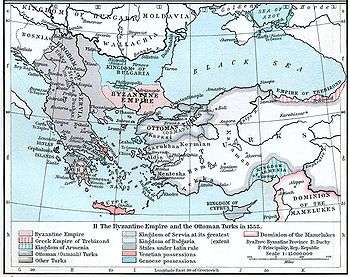
Stefan Dečanski was overthrown in 1331 by his son, Stefan Dušan. Taking advantage of the Byzantine civil war of 1341–1347, Dušan doubled the size of his kingdom, seizing territories to the south, southeast, and east at the expense of Byzantium. He conquered almost the entire territory of present-day Greece, except for the Peloponnese and the islands. After he conquered the city of Serres, he was crowned the Emperor of Serbs and Greeks in Skoplje by the Serbian Patriarch, on April 16, 1346. His goal was to become the successor of the Byzantine Emperors, and he tried to organize a Crusade with the Pope against the threatening Turks.
The Imperial constitution, Dušan's Code (Serbian: Dušanov zakonik),[10] was enacted in 1349 and amended in 1354. The Code was based on Roman-Byzantine law. The legal transplanting is notable within articles 171 and 172 of Dušan's Code, which regulated the juridical independence. They were taken from the Byzantine code Basilika (book VII, 1, 16-17). Dušan opened new trade routes and strengthened the economy of the state. Serbia flourished, becoming one of the most developed countries and cultures in Europe, with a high political, economic, and cultural reputation.
Dušan died suddenly in December 1355 at age 47.
Administration
Monarchs
| King | Reign | Notes |
|---|---|---|
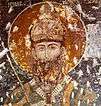 Stefan Nemanjić Stefan Nemanjićthe First-crowned | 1217-1228 |
|
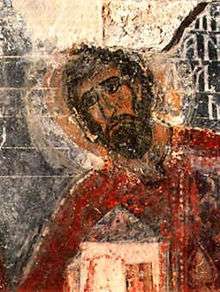 Stefan Radoslav Stefan Radoslav | 1228–1233 |
|
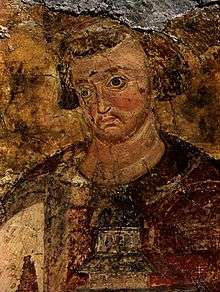 Stefan Vladislav Stefan Vladislav | 1233–1243 |
|
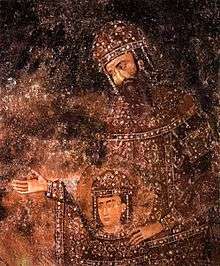 Stefan Uroš I Stefan Uroš I | 1243–1276 |
|
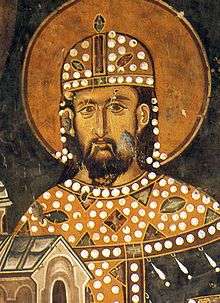 Stefan Dragutin Stefan Dragutin | 1276-1282 |
|
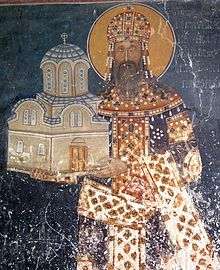 Stefan Milutin Stefan Milutin | 1282–1321 |
|
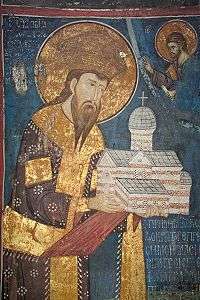 Stefan Dečanski Stefan Dečanski | 1321–1331 |
|
 Stefan Dušan Stefan Dušanthe Mighty | 1331-1355 |
|
See also
Part of a series on the |
||||||||||||||||
|---|---|---|---|---|---|---|---|---|---|---|---|---|---|---|---|---|
| History of Serbia | ||||||||||||||||
 | ||||||||||||||||
|
||||||||||||||||
|
||||||||||||||||
|
||||||||||||||||
|
||||||||||||||||
|
||||||||||||||||
|
| ||||||||||||||||
References
- 1 2 Fine, 233
- 1 2 3 Fine, p. 224
- ↑ The early medieval Balkans, p. 224
- ↑ Fine, p. 225
- ↑ http://www.alanwatson.org/sr/petarzoric.pdf Alan Watson Foundation
- ↑ "Nomocanon". Search.com Reference. Retrieved 2010-07-25.
- ↑ John V. A. Fine (1994). The Late Medieval Balkans: A Critical Survey from the Late Twelfth Century to the Ottoman Conquest. ISBN 978-0-472-08260-5. Retrieved 2010-07-25.
- ↑ S. P. Scott (1932). The Civil Law: Vol. I. Constitution.org. Retrieved 2010-07-25.
- ↑ Yves LASSARD, Alexandr KOPTEV. "The Roman Law Library". Web.upmf-grenoble.fr. Retrieved 2010-07-25.
- ↑ "Serbian Culture of the 14th Century. Volume I". Dusanov Zakonik. Retrieved 2010-07-25.
Sources
- John V.A. Fine. (1994). The Late Medieval Balkans: A Critical Survey from the Late Twelfth Century to the Ottoman Conquest. The University of Michigan Press. ISBN 0-472-08260-4
- John V.A. Fine. (1991). The early Medieval Balkans: A Critical Survey from the 6th to the Late 12th Century. The University of Michigan Press. ISBN 0-472-08149-7
- Alexander Soloviev, "Greek charters of Serbian rulers" (1936), Soloviev and Makin
